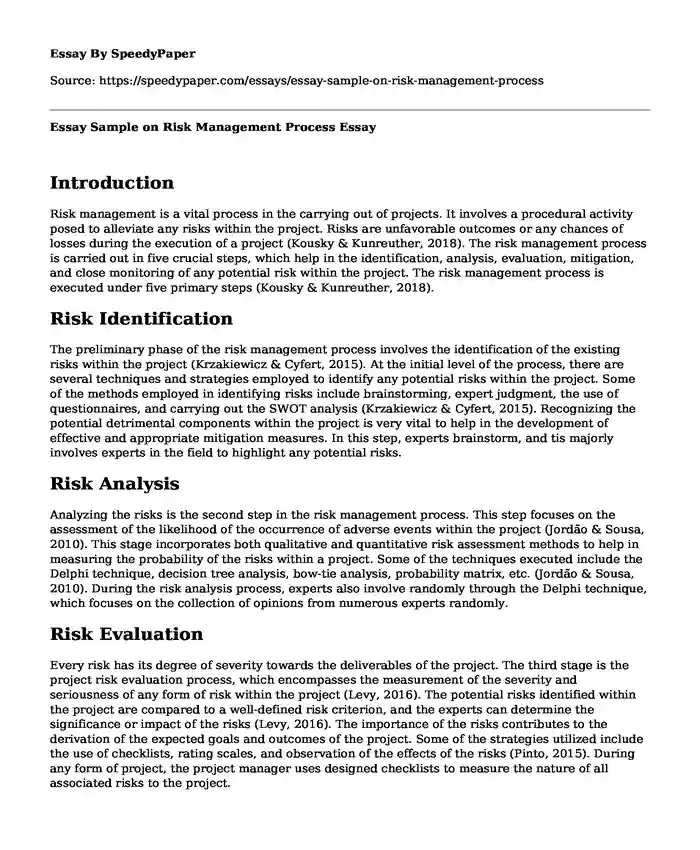
| Type of paper: | Essay |
| Categories: | Risk management Organizational culture |
| Pages: | 3 |
| Wordcount: | 800 words |
Introduction
Risk management is a vital process in the carrying out of projects. It involves a procedural activity posed to alleviate any risks within the project. Risks are unfavorable outcomes or any chances of losses during the execution of a project (Kousky & Kunreuther, 2018). The risk management process is carried out in five crucial steps, which help in the identification, analysis, evaluation, mitigation, and close monitoring of any potential risk within the project. The risk management process is executed under five primary steps (Kousky & Kunreuther, 2018).
Risk Identification
The preliminary phase of the risk management process involves the identification of the existing risks within the project (Krzakiewicz & Cyfert, 2015). At the initial level of the process, there are several techniques and strategies employed to identify any potential risks within the project. Some of the methods employed in identifying risks include brainstorming, expert judgment, the use of questionnaires, and carrying out the SWOT analysis (Krzakiewicz & Cyfert, 2015). Recognizing the potential detrimental components within the project is very vital to help in the development of effective and appropriate mitigation measures. In this step, experts brainstorm, and tis majorly involves experts in the field to highlight any potential risks.
Risk Analysis
Analyzing the risks is the second step in the risk management process. This step focuses on the assessment of the likelihood of the occurrence of adverse events within the project (Jordao & Sousa, 2010). This stage incorporates both qualitative and quantitative risk assessment methods to help in measuring the probability of the risks within a project. Some of the techniques executed include the Delphi technique, decision tree analysis, bow-tie analysis, probability matrix, etc. (Jordao & Sousa, 2010). During the risk analysis process, experts also involve randomly through the Delphi technique, which focuses on the collection of opinions from numerous experts randomly.
Risk Evaluation
Every risk has its degree of severity towards the deliverables of the project. The third stage is the project risk evaluation process, which encompasses the measurement of the severity and seriousness of any form of risk within the project (Levy, 2016). The potential risks identified within the project are compared to a well-defined risk criterion, and the experts can determine the significance or impact of the risks (Levy, 2016). The importance of the risks contributes to the derivation of the expected goals and outcomes of the project. Some of the strategies utilized include the use of checklists, rating scales, and observation of the effects of the risks (Pinto, 2015). During any form of project, the project manager uses designed checklists to measure the nature of all associated risks to the project.
Risk Mitigation or Treatment
The main aim of the risk management process is the treatment and mitigation of any adverse effects accompanied by the risks. In this stage, the project manager focuses on the management and eradication of the project risks (Card, Ward & Clarkson, 2014). Some of the techniques used are risk avoidance, retention, risk sharing, and reduction of the risks (Card, Ward & Clarkson, 2014). Various experts and project managers employ a selected mitigation plan following the severity of the risk (Zid, Kasim & Soomro, 2020). If the risk is enormous, risk sharing is undertaken through the use of insurance policies and programs to distribute the risks involved in the project.
Conclusion
This is the final phase of the risk management process. It focuses on the establishment of pf strategies to monitor the progress of the project and any other potential risk that would arise over time (Pinto, 2015). Effective project managers undertake robust monitoring programs to help in the observation of ay flaws or hazards within the project. The project managers establish effective mitigation plans that help in monitoring all operations of the project and curb any potential problems that can arise over time (Pinto, 2015).
References
Bernie Roseke, P. (2019). The 4 Types of Project Organizational Structure. Retrieved 14 August 2020, from https://www.projectengineer.net/the-4-types-of-project-organizational-structure/
Card, A., Ward, J., & Clarkson, P. (2014). Rebalancing risk management-Part 1: The Process for Active Risk Control (PARC). Journal Of Healthcare Risk Management, 34(2), 21-30.
doi: 10.1002/jhrm.21155
Jordao, B., & Sousa, E. (2010). Risk management. New York: Nova Science Publishers.
Kousky, C., & Kunreuther, H. (2018). Risk Management Roles of the Public and Private Sector. Risk Management And Insurance Review, 21(1), 181-204.
doi: 10.1111/rmir.12096
Krzakiewicz, K., & Cyfert, S. (2015). Organizational reputation risk management as a component of the dynamic capabilities management process. Management, 19(1), 6-18.
doi: 10.1515/manment-2015-0001
Levy, J. (2016). Fine Particulate Matter, Risk Assessment, and Risk Management. Risk Analysis, 36(9), 1745-1747.
doi: 10.1111/risa.12673
Pinto, C. (2015). Operational Risk Management. Momentum Press.
Winch, G. (2014). Three domains of project organizing. International Journal Of Project Management, 32(5), 721-731. doi: 10.1016/j.ijproman.2013.10.012
Zid, C., Kasim, N., & Soomro, A. (2020). Effective project management approach to attain project success based on cost-time-quality. International Journal Of Project Organisation And Management, 12(2), 149.
doi: 10.1504/ijpom.2020.10027903
Cite this page
Essay Sample on Risk Management Process. (2023, Nov 06). Retrieved from https://speedypaper.com/essays/essay-sample-on-risk-management-process
Request Removal
If you are the original author of this essay and no longer wish to have it published on the SpeedyPaper website, please click below to request its removal:
- Project Management Essay Sample: Equipping a Sound (Record) Studio
- The New Pay Plan Essay Sample
- Paper Example on Billing and Reimbursement in St Joseph Hospital
- Culturally Diverse Classrooms. Paper Example
- Free Essay: Community Development, Theoretical Perspectives
- Cross-Cultural Communication - Free Paper Sample
- Free Paper on Caterpillar Inc.: Navigating Industry Impact and Payout Strategies Amidst Crisis
Popular categories




